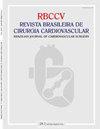尖锐解剖、电灼和超声刀在桡动脉采收过程中内皮损伤、准备时间和术后出血的比较
IF 1.2
4区 医学
Q4 CARDIAC & CARDIOVASCULAR SYSTEMS
Revista Brasileira De Cirurgia Cardiovascular
Pub Date : 2019-12-01
DOI:10.21470/1678-9741-2018-0311
引用次数: 3
摘要
目的探讨经典技术、电切和超声分离对冠状动脉旁路移植术中桡动脉内皮完整性、功能及准备时间的影响。方法对45例行孤立性冠状动脉搭桥且RA适宜的患者进行研究,分为3组:1组采用经典方法(尖锐解剖);第二组,电灼;第三组为超声烧灼。用生化方法检测前列环素和一氧化氮衍生物的水平;免疫组化染色检测血管细胞粘附分子1 (VCAM-1)和内皮一氧化氮合成酶(eNOS)水平。比较RA制备时间、RA长度/收获时间比和RA去除部位的排水量。结果各组RA制备时间(1组25±6 min、2组18±3 min、3组16±3 min, P<0.001)和长度/收获时间比(1组0.76±0.19 cm/min、2组0.98±0.16 cm/min、3组1.13±0.09 cm/min, P<0.001)差异均有统计学意义。前列环素和一氧化氮衍生物水平差异无统计学意义,各组之间VCAM-1和eNOS表达相似,每组仅1例患者检测到内皮损伤。结论超声烧灼术在RA预备术中应用,可显著减少RA预备时间和术后引流量。然而,当考虑到存在内皮损伤的生化和组织病理学评估时,一种方法优于其他方法的优势无法证明。本文章由计算机程序翻译,如有差异,请以英文原文为准。
Comparison of Sharp Dissection, Electrocautery, and Ultrasonic Activated Scalpel with Regard to Endothelial Damage, Preparation Time, and Postoperative Bleeding During Radial Artery Harvesting
Objective To examine the effects of classical technique, electrocautery, and ultrasonic dissection on endothelial integrity, function, and preparation time for harvesting the radial artery (RA) during coronary artery bypass grafting (CABG). Methods Forty-five patients who underwent isolated CABG and whose RA was suitable for use were studied and divided into three groups: Group 1, classical method (using sharp dissection); Group 2, electrocautery; and Group 3, ultrasonic cautery. Levels of prostacyclin and nitric oxide derivatives were examined biochemically; vascular cell adhesion molecule 1 (VCAM-1) and endothelial nitric oxide synthetase (eNOS) values were assessed using immunohistochemical staining. RA preparation time, RA length/harvesting time ratio, and drainage amounts at the site of RA removal were compared. Results Differences in RA preparation time (Group 1: 25±6 min, Group 2: 18±3 min, Group 3: 16±3 min, P<0.001) and length/harvesting time ratio (Group 1: 0.76±0.19 cm/min, Group 2: 0.98±0.16 cm/min, Group 3: 1.13±0.09 cm/min, P<0.001) were statistically significant among the groups. Levels of prostacyclin and nitric oxide derivatives were not statistically significant different, VCAM-1 and eNOS expressions were observed to be similar among the groups, and endothelial damage was detected in only one patient per group. Conclusion Use of ultrasonic cautery during RA preparation considerably reduces the preparation time and postoperative drainage amount. However, the superiority of one method over the others could not be demonstrated when the presence of endothelial damage with both biochemical and histopathological evaluations was considered.
求助全文
通过发布文献求助,成功后即可免费获取论文全文。
去求助
来源期刊

Revista Brasileira De Cirurgia Cardiovascular
CARDIAC & CARDIOVASCULAR SYSTEMS-SURGERY
CiteScore
2.10
自引率
0.00%
发文量
176
审稿时长
20 weeks
期刊介绍:
Brazilian Journal of Cardiovascular Surgery (BJCVS) is the official journal of the Brazilian Society of Cardiovascular Surgery (SBCCV). BJCVS is a bimonthly, peer-reviewed scientific journal, with regular circulation since 1986.
BJCVS aims to record the scientific and innovation production in cardiovascular surgery and promote study, improvement and professional updating in the specialty. It has significant impact on cardiovascular surgery practice and related areas.
 求助内容:
求助内容: 应助结果提醒方式:
应助结果提醒方式:


